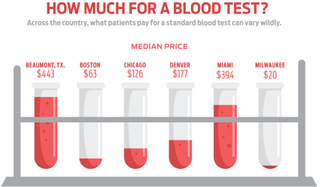Drug Price Info Is No Cure for Sticker Shock
Efforts to curb spending raise questions about just how competitive health care can be.

Chances are you’ve weighed a trip to the doctor based on how poorly you feel as well as how much you will pay the provider. But good luck comparison-shopping. The amounts paid by health insurers for identical services are shrouded in secrecy and can vary widely, even within the same state, metropolitan area or neighborhood.
Because these “contract negotiated rates” are typically the result of intense, closed-door negotiations between individual insurers and health care providers, patients rarely know how much they’ll pay for a procedure or service until after they’ve used it. And with the rise of high-deductible health insurance plans, which require consumers to pay more out of pocket, many patients are feeling the pain of steep, opaque costs.
Over the past few years, the Trump administration has tried a few different approaches to bring down health care costs, mostly centered on making the system operate more like a free market. One of the latest ideas: price transparency. An executive order issued in June says patients can make better-informed decisions if they know the price and quality of a service in advance.

Sign up for Kiplinger’s Free E-Newsletters
Profit and prosper with the best of expert advice on investing, taxes, retirement, personal finance and more - straight to your e-mail.
Profit and prosper with the best of expert advice - straight to your e-mail.
Tough to implement. Supporters of the move say it will improve competition and lower prices. But industry groups representing both hospitals and insurance providers have spoken out against the order, suggesting transparency could actually raise prices.
Some industry analysts have also expressed skepticism that the executive order will radically alter the current landscape. “Most patients don’t think of health care as something you can shop around for, and there’s not much incentive when you don’t foot most of the bill directly,” says Larry Levitt, executive vice president of health policy at the Kaiser Family Foundation. “And in areas where hospitals effectively have monopoly power or significant market leverage, seeing what their competitors are paid elsewhere could push them to ask for more—rather than shame them into asking for less.”
And in a blow to the administration’s strategy, a federal judge threw out a rule instructing drug companies to display the sticker price of their products in television ads, saying the government lacked the authority under current law.
The Department of Health and Human Services (HHS) has to figure out how to implement the president’s executive order and define “price transparency”—a process that will likely take several months. HHS could require service providers to publish their negotiated rates, along with quality-related statistics, such as mortality rates and incidences of hospital-acquired infections associated with services. Or it could adopt a less-sweeping approach that would allow hospitals to simply post the price range for a given service.
Supporters of price transparency say that still wouldn’t tell you how much care would cost under your insurance plan. “We need complete systemwide price transparency to make it work, which means full negotiated rates across all plans, all systems, in real-time,” says Cynthia Fisher, a life sciences entrepreneur and CEO who has pushed for price transparency in Washington for years. “Consumers can shop around when prices are accessible and searchable, and when consumers can shop around, we’ll see prices come down.”

Get Kiplinger Today newsletter — free
Profit and prosper with the best of Kiplinger's advice on investing, taxes, retirement, personal finance and much more. Delivered daily. Enter your email in the box and click Sign Me Up.

-
 RMD Deadline April 1: Five Tax Strategies to Manage Your 2025 Income
RMD Deadline April 1: Five Tax Strategies to Manage Your 2025 IncomeTaxable Income The April 1, 2025, deadline for required minimum distributions (RMDs) is fast approaching for retirees who turned 73 in 2024.
By Kelley R. Taylor Published
-
 Rising AI Demand Stokes Undersea Investments
Rising AI Demand Stokes Undersea InvestmentsThe Kiplinger Letter As demand soars for AI, there’s a need to transport huge amounts of data across oceans. Tech giants have big plans for new submarine cables, including the longest ever.
By John Miley Published
-
 Roth IRA Contribution Limits for 2025
Roth IRA Contribution Limits for 2025Roth IRAs Roth IRA contribution limits have gone up. Here's what you need to know.
By Jackie Stewart Last updated
-
 Four Tips for Renting Out Your Home on Airbnb
Four Tips for Renting Out Your Home on Airbnbreal estate Here's what you should know before listing your home on Airbnb.
By Miriam Cross Published
-
 Five Ways to a Cheap Last-Minute Vacation
Five Ways to a Cheap Last-Minute VacationTravel It is possible to pull off a cheap last-minute vacation. Here are some tips to make it happen.
By Vaishali Varu Last updated
-
 How to Figure Out How Much Life Insurance You Need
How to Figure Out How Much Life Insurance You Needinsurance Instead of relying on rules of thumb, you’re better off taking a systematic approach to figuring your life insurance needs.
By Kimberly Lankford Last updated
-
 Amazon Big Deal Days Is Coming! We’ve Got All the Details
Amazon Big Deal Days Is Coming! We’ve Got All the DetailsAmazon Prime To kick off the holiday season with a bang, Amazon Big Deal Days runs Tuesday, October 8 and Wednesday, October 9.
By Bob Niedt Last updated
-
 How to Shop for Life Insurance in 3 Easy Steps
How to Shop for Life Insurance in 3 Easy Stepsinsurance Shopping for life insurance? You may be able to estimate how much you need online, but that's just the start of your search.
By Kaitlin Pitsker Last updated
-
 Five Ways to Shop for a Low Mortgage Rate
Five Ways to Shop for a Low Mortgage RateBecoming a Homeowner Mortgage rates are high this year, but you can still find an affordable loan with these tips.
By Daniel Bortz Last updated
-
 Retirees, It's Not Too Late to Buy Life Insurance
Retirees, It's Not Too Late to Buy Life Insurancelife insurance Improvements in underwriting have made it easier to qualify for life insurance, which can be a useful estate-planning tool.
By David Rodeck Published